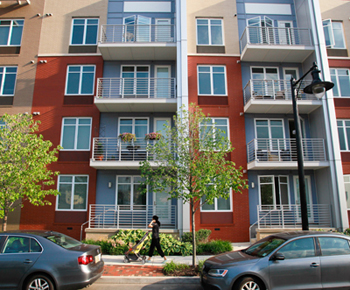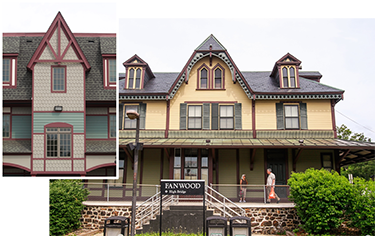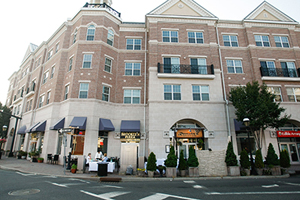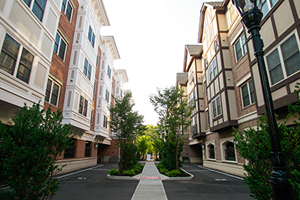In New Jersey, Transit-Oriented Development Comes in All Shapes and Sizes
Designers Share Perspectives on the Keys to Creating Unique Projects
There are the investors, who want to see as many units squeezed into a property as possible. There are the towns, which demand projects abide by intricate sets of local zoning regulations. And there are the residents, who sometimes cast a skeptical eye toward what an application will mean to their schools and traffic.
Guiding a transit-oriented development (TOD) through to fruition can be an exercise in navigating competing interests. For architects, finding ways to artfully compromise can mean compromising art. Yet throughout New Jersey, several unique TOD designs have emerged through the process over the last few years and become embraced in their communities.

The Harrison Station mixed-use complex incorporated building materials
with an industrial flavor as a nod to the town’s history.
One of the keys to TOD design is to strike a balance between fitting with the context of the neighborhood while still being different enough to be recognized as a new project, according to David Minno, a principal at Minno & Wasko Architects and Planners of Lambertville, New Jersey. For example, TODs the firm completed in the older downtown settings of Cranford and Rahway blended modern urban design elements with traditional brickwork details meant to complement some of the historic buildings in the areas.
However, the Town of Harrison presented a far different canvass to work with. Once called “a beehive of industry” by a visiting President William Howard Taft, Harrison was a mile-square manufacturing mecca packed with factories owned by corporations like RCA and General Electric, but experienced a steady decline in the post-World War II decades. In 2003, the town adopted an ambitious redevelopment plan that aimed to replace a district of decaying factories with a vibrant transit village.
The core of these efforts was the PATH train, which offers 20-minute trips to Manhattan around the clock for $2.50. Minno & Wasko designed the 275-unit Harrison Station mixed-use complex across the street.
“Our response architecturally was to be a little more industrial, techie and kind of urban in the approach because we weren’t necessarily trying to fit in with a quaint downtown,” Minno said. To that end, the buildings incorporated materials like metallic panels and sunscreens, concrete highlights and masonry walls.
“We’re not trying to reproduce what would look like a renovated factory, but I think we’re trying to call back to people, with material selections in particular, that this is a little bit edgier,” he said.
New Buildings Take on Historic Themes
Architects have been more deliberate in emulating the historic look of Fanwood. A decade ago, the borough adopted a downtown revitalization plan that required new structures in the district be designed in the Victorian Stick architectural style of its train station. The 1874 building, listed on the National Register of Historic Places, is a local icon and one of a handful of surviving Victorian station structures on the modern day NJ Transit rail lines.
Developers responded with a series of projects that adopted some of the turrets, decorative woodwork, steep-pitched roofs and gingerbread house colors that were typical of the era’s architecture. One of those was the Fanwood Crossing apartment and retail project across the street from the station.

Woodwork details of the Fanwood Crossing development (top left) took on the
style of the 1874 train station across the street.
“The redevelopment plan was helpful, but not restrictive,” said David Checchio, general counsel for Fanwood Crossing developer Elite Properties. “It was a good balance. It did what a good redevelopment should do: It laid the groundwork and foundation for redevelopment in Fanwood.”
Three stops away on the Raritan Valley Line, developer Garden Properties opened a Tudor Revival-style apartment building last year near Cranford Station. But in this case, the throwback look was prompted by a desire for variety rather than any municipal design guidelines.
“The idea that we had—and the architect and the township also liked it—is that every building is going to have a different style, a different look,” project manager Eugene Kouzma said of the Riverfront at Cranford Station complex. “We thought it would be better than if you had the same buildings looking the same way.”
For other projects, the historic flavor has come readymade. Older urban areas like Hoboken, Jersey City and Newark in particular are seeing an increasing number of transit-accessible industrial sites and abandoned public buildings repurposed as trendy residential apartments that command premium rents.
Minno said his firm is currently working on another project in Harrison that would convert three former Edison Lamp Works buildings into a residential complex. The plan is to maintain the exterior of the oldest of the three buildings, a late 1800s space that once served as a lab space for Thomas Edison himself. Minno noted that the narrow streetscape between the former factory buildings will give it a unique “European feel” once it’s restored and landscaped.
Elements for Success
The key for towns that want to encourage creative TOD architecture is to remain open to new ideas and consider exceptions to land use rules, according to Princeton University School of Architecture visiting lecturer J. Robert Hillier.


Two transit-oriented developments in Cranford. Top: Cranford
Crossing was designed to take on a traditional downtown feel.
Above: A Tudor Revival-style building (right) and a more
contemporary structure next to it are both part of the Riverfront
at Cranford Station complex.
“What you need to do is get the typical New Jersey towns out of their frame of mind that everything can only be 35 feet, three stories tall, and you have these outrageous parking requirements,” said Hiller, who is also a principal with Studio Hillier in Princeton, New Jersey.
The demographics and travel behaviors of TOD residents are not only different than those of people who live in suburban single-family homes, but of residents of other high-density residential complexes located away from transit, Hillier said. Given that TOD residents own fewer cars, drive less and have fewer school-age children, Hillier said parking requirements for TODs should be relaxed. Towns should also encourage parking be placed beneath TOD buildings so they’re less separated by blacktop, which he said helps foster a community feel. The space that would have been consumed by parking spaces can offer additional flexibility on the design side.
Local regulations governing density and height are often sore spots for residents and town officials, but allowing relief can mean the difference between a town getting a high-quality or inferior project, Hillier said.
“As soon as you try to do something unusual—and a lot of what we do is unusual—you have to sell the town. [You want to] do something that’s LEED Platinum, but it’s going to look different,” Hillier said, referring the U.S. Green Building Council’s certification for the most energy-efficient and environmentally friendly buildings. “A LEED Platinum roof will generally be flat because it has photovoltaics or sod or both on it, and they’re looking for pitched roofs.”
The ingredients for success are often in place for projects in older downtown areas—namely, dense residential neighborhoods full of potential customers. However, Hillier said some towns have had less success in trying to create transit villages on what were essentially undeveloped greenfields near transit hubs. A common mistake made by local governments, he said, is to demand an unrealistically high percentage of these developments be dedicated to commercial uses—even big box stores that are far out of character for the sort of walkable, bikable communities that transit villages are meant to be. The aim is to bring commercial ratables on to the tax rolls, but when businesses aren’t surrounded by enough residential units to support them, they wind up as empty storefronts.
“You can’t create a downtown. Downtowns have to grow organically,” Hillier said. “You can be the best designer in the world but you just can’t make it perfect. At the beginning, it needs to find its way.”
Karl Vilacoba is the managing editor of InTransition.